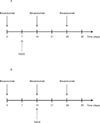Phase 2 trial of concurrent bevacizumab and transhepatic arterial chemoembolization in patients with unresectable hepatocellular carcinoma
- PMID: 23132335
- PMCID: PMC3578139
- DOI: 10.1002/cncr.27859
Phase 2 trial of concurrent bevacizumab and transhepatic arterial chemoembolization in patients with unresectable hepatocellular carcinoma
Abstract
Background: Vascular endothelial growth factor is up-regulated in hepatocellular carcinoma (HCC) and is further up-regulated after transhepatic arterial chemoembolization. The authors of this report conducted a phase 2 trial to evaluate the safety and efficacy of bevacizumab combined with chemoembolization in patients with unresectable HCC.
Methods: Patients who had an Eastern Cooperative Oncology Group performance of status 0 to 2, a Child-Pugh score of A or B, and Barcelona Clinic Liver Cancer stage B or C HCC were eligible. Treatment consisted of bevacizumab every 2 weeks and chemoembolization during the third week of a 6-week cycle for up to 3 cycles over 6 months. The primary endpoints were safety and efficacy.
Results: Twenty-five patients received chemoembolization and bevacizumab. The most common grade 3 and 4 events after the first treatment cycle were leukocytopenia (12%), fatigue (12%), and hyponatremia (12%). Serious toxicities that had a known association with bevacizumab were observed in 4 patients. Thirty-day mortality was 0%. The median time to tumor progression for the targeted lesions was not reached, and overall survival was 10.8 months. The objective response rate was 60% using enhancement response evaluation criteria, and the disease control rate was 100%.
Conclusions: Concurrent treatment with bevacizumab and chemoembolization was safe in carefully selected patients and demonstrated antitumor activity in patients with unresectable HCC. These results support the further development of bevacizumab combined with chemoembolization as a treatment for unresectable HCC.
Copyright © 2012 American Cancer Society.
Figures



Similar articles
-
Hepatocellular Carcinoma: A Phase II Randomized Controlled Double-Blind Trial of Transarterial Chemoembolization in Combination with Biweekly Intravenous Administration of Bevacizumab or a Placebo.Radiology. 2015 Dec;277(3):903-12. doi: 10.1148/radiol.2015142140. Epub 2015 Jul 1. Radiology. 2015. PMID: 26131911 Clinical Trial.
-
Protocol of the IMPACT study: randomized, multicenter, phase 3 study evaluating the efficacy of immunotherapy (Atezolizumab) plus anti-VEGF therapy (Bevacizumab) in combination with transcatheter arterial chemoembolization for unresectable hepatocellular carcinoma.BMC Cancer. 2025 Mar 11;25(1):434. doi: 10.1186/s12885-025-13648-5. BMC Cancer. 2025. PMID: 40069616 Free PMC article.
-
Atezolizumab with or without bevacizumab in unresectable hepatocellular carcinoma (GO30140): an open-label, multicentre, phase 1b study.Lancet Oncol. 2020 Jun;21(6):808-820. doi: 10.1016/S1470-2045(20)30156-X. Lancet Oncol. 2020. PMID: 32502443 Clinical Trial.
-
Transarterial chemoembolization combined with atezolizumab plus bevacizumab conversion therapy for intermediate-stage hepatocellular carcinoma: a case report and literature review.Front Immunol. 2024 May 28;15:1358602. doi: 10.3389/fimmu.2024.1358602. eCollection 2024. Front Immunol. 2024. PMID: 38863699 Free PMC article. Review.
-
Efficacy of 125I Versus Non-125I Combined with Transcatheter Arterial Chemoembolization for the Treatment of Unresectable Hepatocellular Carcinoma with Obstructive Jaundice.Dig Dis Sci. 2018 Feb;63(2):321-328. doi: 10.1007/s10620-017-4899-x. Epub 2018 Jan 5. Dig Dis Sci. 2018. PMID: 29305738 Review.
Cited by
-
Clinically approved combination immunotherapy: Current status, limitations, and future perspective.Curr Res Immunol. 2022 Jun 3;3:118-127. doi: 10.1016/j.crimmu.2022.05.003. eCollection 2022. Curr Res Immunol. 2022. PMID: 35676925 Free PMC article. Review.
-
The status of transarterial chemoembolization treatment in the era of precision oncology.Hepat Oncol. 2017 Apr;4(2):55-63. doi: 10.2217/hep-2017-0009. Epub 2017 Sep 26. Hepat Oncol. 2017. PMID: 28989699 Free PMC article. Review.
-
Systemic therapy for hepatocellular carcinoma.Hepat Oncol. 2014 Jan;1(1):23-38. doi: 10.2217/hep.13.10. Epub 2013 Dec 20. Hepat Oncol. 2014. PMID: 30190939 Free PMC article. Review.
-
Identification of Novel Anti-Liver Cancer Small Molecules with Better Therapeutic Index than Sorafenib via Zebrafish Drug Screening Platform.Cancers (Basel). 2019 May 28;11(6):739. doi: 10.3390/cancers11060739. Cancers (Basel). 2019. PMID: 31141996 Free PMC article.
-
Trial Watch: Tumor-targeting monoclonal antibodies in cancer therapy.Oncoimmunology. 2014 Jan 1;3(1):e27048. doi: 10.4161/onci.27048. Oncoimmunology. 2014. PMID: 24605265 Free PMC article. Review.
References
-
- Parkin DM. Global cancer statistics in the year 2000. Lancet Oncol. 2001;2(9):533–543. - PubMed
-
- Yeung YP, Lo CM, Liu CL, Wong BC, Fan ST, Wong J. Natural history of untreated nonsurgical hepatocellular carcinoma. Am J Gastroenterol. 2005;100(9):1995–2004. - PubMed
-
- Cheng AL, Kang YK, Chen Z, Tsao CJ, Qin S, Kim JS, et al. Efficacy and safety of sorafenib in patients in the Asia-Pacific region with advanced hepatocellular carcinoma: a phase III randomised, double-blind, placebo-controlled trial. Lancet Oncol. 2009;10(1):25–34. - PubMed
-
- Llovet JM, Ricci S, Mazzaferro V, Hilgard P, Gane E, Blanc JF, et al. Sorafenib in advanced hepatocellular carcinoma. N Engl J Med. 2008;359(4):378–390. - PubMed
Publication types
MeSH terms
Substances
Grants and funding
LinkOut - more resources
Full Text Sources
Medical

